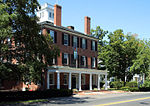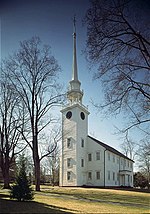Stanley-Whitman House
1720 establishments in ConnecticutHistoric house museums in ConnecticutHouses completed in 1720Houses in Farmington, ConnecticutHouses on the National Register of Historic Places in Connecticut ... and 6 more
Individually listed contributing properties to historic districts on the National Register in ConnecticutMuseums in Hartford County, ConnecticutNRHP infobox with nocatNational Historic Landmarks in ConnecticutNational Register of Historic Places in Hartford County, ConnecticutSaltbox architecture in Connecticut

The Stanley-Whitman House is a historic house museum at 37 High Street in Farmington, Connecticut. Built ca 1720, it is one of the oldest houses in Farmington. A well-preserved saltbox with post-medieval construction features, it was designated a National Historic Landmark in 1960 and National Register of Historic Places when the registry opened in 1966.
Excerpt from the Wikipedia article Stanley-Whitman House (License: CC BY-SA 3.0, Authors, Images).Stanley-Whitman House
High Street,
Geographical coordinates (GPS) Address Website External links Nearby Places Show on map
Geographical coordinates (GPS)
| Latitude | Longitude |
|---|---|
| N 41.721736111111 ° | E -72.825061111111 ° |
Address
Stanley-Whitman House Museum
High Street 37
06032
Connecticut, United States
Open on Google Maps










